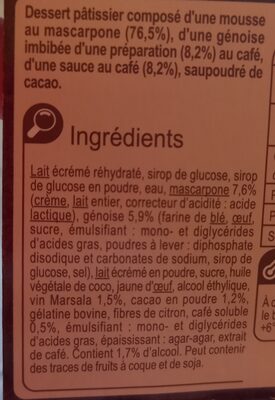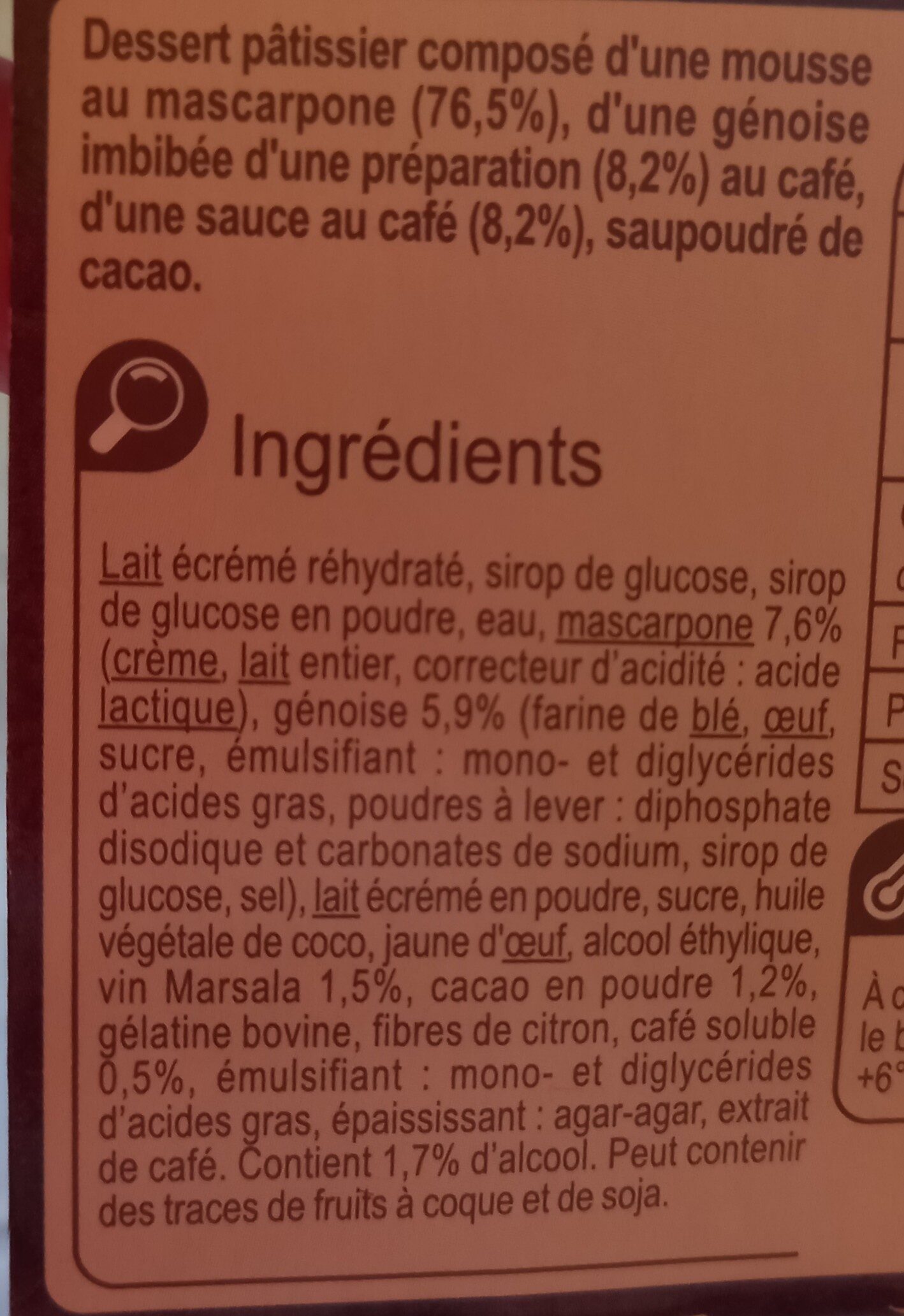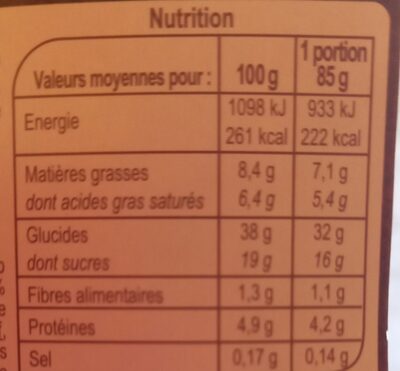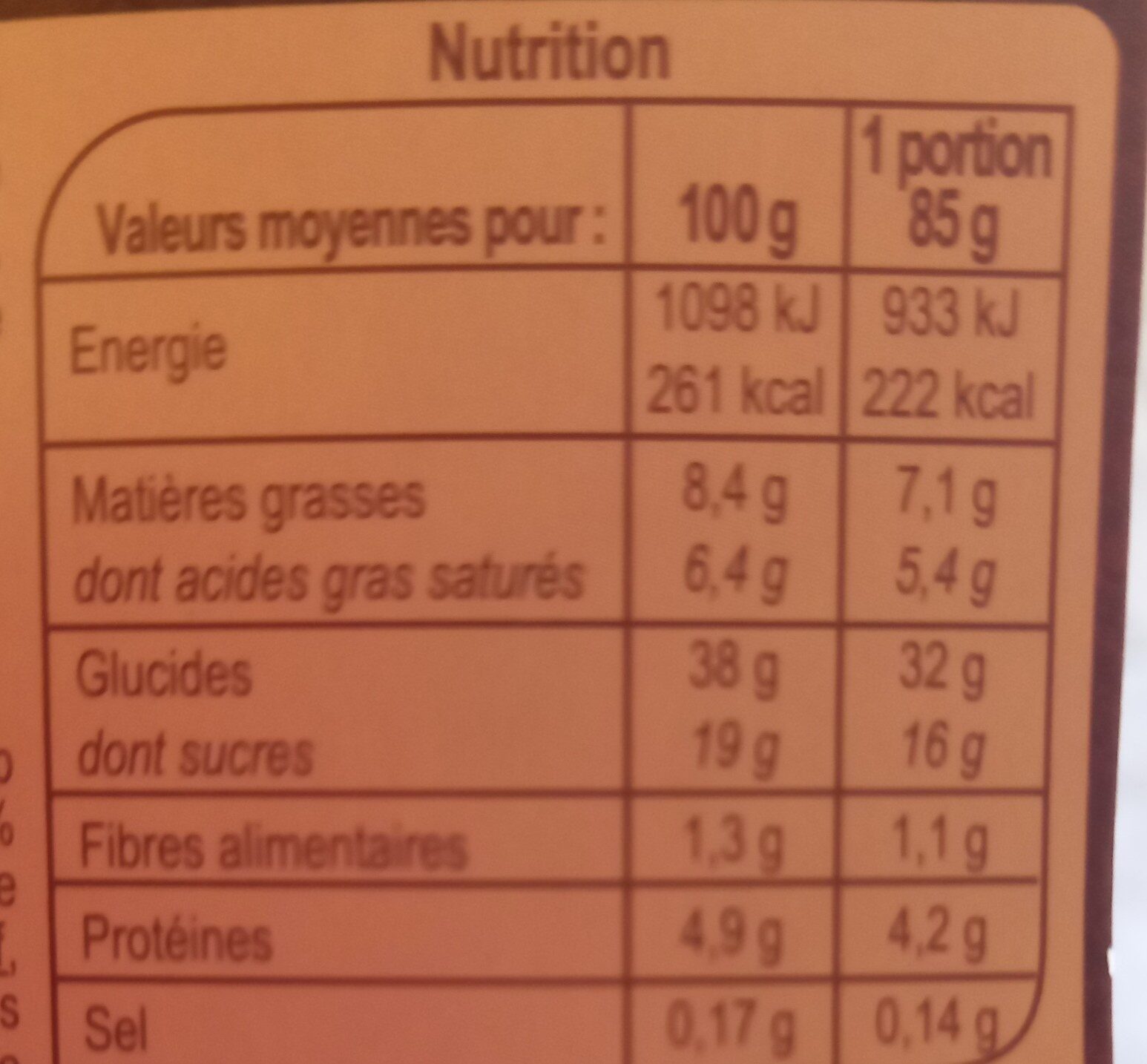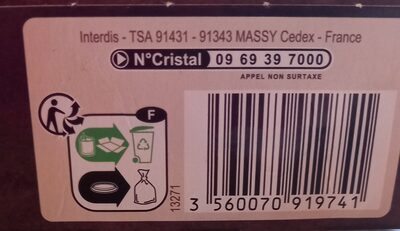Help us make food transparency the norm!
As a non-profit organization, we depend on your donations to continue informing consumers around the world about what they eat.
The food revolution starts with you!
Dessert Tiramisu - Carrefour Sélection - 85 g
Dessert Tiramisu - Carrefour Sélection - 85 g
This product page is not complete. You can help to complete it by editing it and adding more data from the photos we have, or by taking more photos using the app for Android or iPhone/iPad. Thank you!
×
Some of the data for this product has been provided directly by the manufacturer Carrefour.
Barcode: 3560070919741 (EAN / EAN-13)
Common name: Dessert pâtissier composé d'une mousse au mascarpone (76,5%), d'une génoise imbibée d'une préparation (8,2%) au café, d'une sauce au café (8,2%), saupoudré de cacao.
Quantity: 85 g
Packaging: Glass, fr:Emballage carton, fr:Opercule plastique
Brands: Carrefour Sélection, Carrefour
Categories: Dairies, Snacks, Desserts, Sweet snacks, Dairy desserts, Frozen foods, Biscuits and cakes, Pastries, Tiramisu
Labels, certifications, awards: Made in Italy, Nutriscore, Nutriscore Grade D
Traceability code: IT, 03 258, CE
Stores: Carrefour, carrefour.fr
Countries where sold: France
Matching with your preferences
Health
Ingredients
-
37 ingredients
: Lait écrémé réhydraté, sirop de glucose, sirop de glucose en poudre, eau, mascarpone 7,6% F (crème, lait entier, correcteur d'acidité: acide lactique), génoise 5,9% (farine de blé, œuf, sucre, émulsifiant: mono - et diglycérides s S d'acides gras, poudres à lever: diphosphate disodique et carbonates de sodium, sirop de glucose, sel), lait écrémé en poudre, sucre, huile végétale de coco, jaune d'œuf, alcool éthylique, vin Marsala 1,5%, cacao en poudre 1,2%, Ad gélatine bovine, fibres de citron, café soluble 0,5%, émulsifiant : mono - et diglycérides +6 d'acides gras, épaississant: agar-agar, extrait de café. Contient 1,7% d'alcool. Peut contenir des traces de fruits à coque et de soja. le bAllergens: Eggs, Gluten, MilkTraces: Nuts, Soybeans
Food processing
-
Ultra processed foods
Elements that indicate the product is in the 4 - Ultra processed food and drink products group:
- Additive: E406 - Agar
- Additive: E450 - Diphosphates
- Ingredient: Emulsifier
- Ingredient: Glucose
- Ingredient: Glucose syrup
- Ingredient: Thickener
Food products are classified into 4 groups according to their degree of processing:
- Unprocessed or minimally processed foods
- Processed culinary ingredients
- Processed foods
- Ultra processed foods
The determination of the group is based on the category of the product and on the ingredients it contains.
Additives
-
E1510 - Ethanol
Ethanol: Ethanol, also called alcohol, ethyl alcohol, grain alcohol, and drinking alcohol, is a chemical compound, a simple alcohol with the chemical formula C2H5OH. Its formula can be also written as CH3−CH2−OH or C2H5−OH -an ethyl group linked to a hydroxyl group-, and is often abbreviated as EtOH. Ethanol is a volatile, flammable, colorless liquid with a slight characteristic odor. It is a psychoactive substance and is the principal type of alcohol found in alcoholic drinks. Ethanol is naturally produced by the fermentation of sugars by yeasts or via petrochemical processes, and is most commonly consumed as a popular recreational drug. It also has medical applications as an antiseptic and disinfectant. The compound is widely used as a chemical solvent, either for scientific chemical testing or in synthesis of other organic compounds, and is a vital substance used across many different kinds of manufacturing industries. Ethanol is also used as a clean-burning fuel source.Source: Wikipedia
-
E270 - Lactic acid
Lactic acid: Lactic acid is an organic compound with the formula CH3CH-OH-COOH. In its solid state, it is white and water-soluble. In its liquid state, it is colorless. It is produced both naturally and synthetically. With a hydroxyl group adjacent to the carboxyl group, lactic acid is classified as an alpha-hydroxy acid -AHA-. In the form of its conjugate base called lactate, it plays a role in several biochemical processes. In solution, it can ionize a proton from the carboxyl group, producing the lactate ion CH3CH-OH-CO−2. Compared to acetic acid, its pKa is 1 unit less, meaning lactic acid deprotonates ten times more easily than acetic acid does. This higher acidity is the consequence of the intramolecular hydrogen bonding between the α-hydroxyl and the carboxylate group. Lactic acid is chiral, consisting of two optical isomers. One is known as L--+--lactic acid or -S--lactic acid and the other, its mirror image, is D--−--lactic acid or -R--lactic acid. A mixture of the two in equal amounts is called DL-lactic acid, or racemic lactic acid. Lactic acid is hygroscopic. DL-lactic acid is miscible with water and with ethanol above its melting point which is around 17 or 18 °C. D-lactic acid and L-lactic acid have a higher melting point. In animals, L-lactate is constantly produced from pyruvate via the enzyme lactate dehydrogenase -LDH- in a process of fermentation during normal metabolism and exercise. It does not increase in concentration until the rate of lactate production exceeds the rate of lactate removal, which is governed by a number of factors, including monocarboxylate transporters, concentration and isoform of LDH, and oxidative capacity of tissues. The concentration of blood lactate is usually 1–2 mM at rest, but can rise to over 20 mM during intense exertion and as high as 25 mM afterward. In addition to other biological roles, L-lactic acid is the primary endogenous agonist of hydroxycarboxylic acid receptor 1 -HCA1-, which is a Gi/o-coupled G protein-coupled receptor -GPCR-.In industry, lactic acid fermentation is performed by lactic acid bacteria, which convert simple carbohydrates such as glucose, sucrose, or galactose to lactic acid. These bacteria can also grow in the mouth; the acid they produce is responsible for the tooth decay known as caries. In medicine, lactate is one of the main components of lactated Ringer's solution and Hartmann's solution. These intravenous fluids consist of sodium and potassium cations along with lactate and chloride anions in solution with distilled water, generally in concentrations isotonic with human blood. It is most commonly used for fluid resuscitation after blood loss due to trauma, surgery, or burns.Source: Wikipedia
-
E406 - Agar
Agar: Agar -pronounced , sometimes - or agar-agar is a jelly-like substance, obtained from red algae.Agar is a mixture of two components: the linear polysaccharide agarose, and a heterogeneous mixture of smaller molecules called agaropectin. It forms the supporting structure in the cell walls of certain species of algae, and is released on boiling. These algae are known as agarophytes, and belong to the Rhodophyta -red algae- phylum.Agar has been used as an ingredient in desserts throughout Asia, and also as a solid substrate to contain culture media for microbiological work. Agar can be used as a laxative, an appetite suppressant, a vegetarian substitute for gelatin, a thickener for soups, in fruit preserves, ice cream, and other desserts, as a clarifying agent in brewing, and for sizing paper and fabrics.The gelling agent in agar is an unbranched polysaccharide obtained from the cell walls of some species of red algae, primarily from tengusa -Gelidiaceae- and ogonori -Gracilaria-. For commercial purposes, it is derived primarily from ogonori. In chemical terms, agar is a polymer made up of subunits of the sugar galactose.Source: Wikipedia
-
E450 - Diphosphates
Diphosphates (E450) are food additives often utilized to modify the texture of products, acting as leavening agents in baking and preventing the coagulation of canned food.
These salts can stabilize whipped cream and are also found in powdered products to maintain their flow properties. They are commonly present in baked goods, processed meats, and soft drinks.
Derived from phosphoric acid, they're part of our daily phosphate intake, which often surpasses recommended levels due to the prevalence of phosphates in processed foods and drinks.
Excessive phosphate consumption is linked to health issues, such as impaired kidney function and weakened bone health. Though diphosphates are generally regarded as safe when consumed within established acceptable daily intakes, it's imperative to monitor overall phosphate consumption to maintain optimal health.
-
E500 - Sodium carbonates
Sodium carbonates (E500) are compounds commonly used in food preparation as leavening agents, helping baked goods rise by releasing carbon dioxide when they interact with acids.
Often found in baking soda, they regulate the pH of food, preventing it from becoming too acidic or too alkaline. In the culinary world, sodium carbonates can also enhance the texture and structure of foods, such as noodles, by modifying the gluten network.
Generally recognized as safe, sodium carbonates are non-toxic when consumed in typical amounts found in food.
Ingredients analysis
-
Palm oil free
No ingredients containing palm oil detected
Unrecognized ingredients: fr:mascarpone-7-6-f, fr:mono-et-diglycerides-s-s-d-acides-gras, fr:ad-gelatine-bovine, fr:mono-et-diglycerides-6-d-acides-gras, fr:contient-1-7-d-alcool, fr:le-bSome ingredients could not be recognized.
We need your help!
You can help us recognize more ingredients and better analyze the list of ingredients for this product and others:
- Edit this product page to correct spelling mistakes in the ingredients list, and/or to remove ingredients in other languages and sentences that are not related to the ingredients.
- Add new entries, synonyms or translations to our multilingual lists of ingredients, ingredient processing methods, and labels.
If you would like to help, join the #ingredients channel on our Slack discussion space and/or learn about ingredients analysis on our wiki. Thank you!
-
Non-vegan
Non-vegan ingredients: Reconstituted skimmed milk, Cream, Whole milk, Egg, Skimmed milk powder, Egg yolkSome ingredients could not be recognized.
We need your help!
You can help us recognize more ingredients and better analyze the list of ingredients for this product and others:
- Edit this product page to correct spelling mistakes in the ingredients list, and/or to remove ingredients in other languages and sentences that are not related to the ingredients.
- Add new entries, synonyms or translations to our multilingual lists of ingredients, ingredient processing methods, and labels.
If you would like to help, join the #ingredients channel on our Slack discussion space and/or learn about ingredients analysis on our wiki. Thank you!
-
Vegetarian status unknown
Unrecognized ingredients: fr:mascarpone-7-6-f, fr:Génoise, fr:mono-et-diglycerides-s-s-d-acides-gras, fr:ad-gelatine-bovine, fr:mono-et-diglycerides-6-d-acides-gras, fr:contient-1-7-d-alcool, fr:le-bSome ingredients could not be recognized.
We need your help!
You can help us recognize more ingredients and better analyze the list of ingredients for this product and others:
- Edit this product page to correct spelling mistakes in the ingredients list, and/or to remove ingredients in other languages and sentences that are not related to the ingredients.
- Add new entries, synonyms or translations to our multilingual lists of ingredients, ingredient processing methods, and labels.
If you would like to help, join the #ingredients channel on our Slack discussion space and/or learn about ingredients analysis on our wiki. Thank you!
-
Details of the analysis of the ingredients
We need your help!
Some ingredients could not be recognized.
We need your help!
You can help us recognize more ingredients and better analyze the list of ingredients for this product and others:
- Edit this product page to correct spelling mistakes in the ingredients list, and/or to remove ingredients in other languages and sentences that are not related to the ingredients.
- Add new entries, synonyms or translations to our multilingual lists of ingredients, ingredient processing methods, and labels.
If you would like to help, join the #ingredients channel on our Slack discussion space and/or learn about ingredients analysis on our wiki. Thank you!
: Lait écrémé réhydraté, sirop de glucose, sirop de glucose en poudre, eau, mascarpone 7.6% F (crème, lait entier, correcteur d'acidité (acide lactique)), génoise 5.9% (farine de blé, œuf, sucre, émulsifiant (mono- et diglycérides s S d'acides gras), poudres à lever (diphosphate disodique, carbonates de sodium), sirop de glucose, sel), lait écrémé en poudre, sucre, huile végétale de coco, jaune d'œuf, alcool éthylique, vin Marsala 1.5%, cacao en poudre 1.2%, Ad gélatine bovine, fibres de citron, café soluble 0.5%, émulsifiant (mono- et diglycérides +6 d'acides gras), épaississant (agar-agar), café, Contient 1.7% d'alcool, le b- Lait écrémé réhydraté -> en:reconstituted-skimmed-milk - vegan: no - vegetarian: yes - ciqual_proxy_food_code: 19051 - percent_min: 5.9 - percent_max: 58.8
- sirop de glucose -> en:glucose-syrup - vegan: yes - vegetarian: yes - ciqual_proxy_food_code: 31016 - percent_min: 5.9 - percent_max: 32.35
- sirop de glucose en poudre -> en:dehydrated-glucose-syrup - vegan: yes - vegetarian: yes - ciqual_proxy_food_code: 31016 - percent_min: 5.9 - percent_max: 23.5333333333333
- eau -> en:water - vegan: yes - vegetarian: yes - ciqual_food_code: 18066 - percent_min: 5.9 - percent_max: 19.125
- mascarpone 7.6% F -> fr:mascarpone-7-6-f - percent_min: 5.9 - percent_max: 16.48
- crème -> en:cream - vegan: no - vegetarian: yes - ciqual_food_code: 19402 - percent_min: 1.96666666666667 - percent_max: 16.48
- lait entier -> en:whole-milk - vegan: no - vegetarian: yes - ciqual_food_code: 19023 - percent_min: 0 - percent_max: 8.24
- correcteur d'acidité -> en:acidity-regulator - percent_min: 0 - percent_max: 5.49333333333333
- acide lactique -> en:e270 - vegan: yes - vegetarian: yes - percent_min: 0 - percent_max: 5.49333333333333
- génoise -> fr:genoise - percent_min: 5.9 - percent: 5.9 - percent_max: 5.9
- farine de blé -> en:wheat-flour - vegan: yes - vegetarian: yes - ciqual_proxy_food_code: 9410 - percent_min: 0.842857142857143 - percent_max: 5.9
- œuf -> en:egg - vegan: no - vegetarian: yes - ciqual_food_code: 22000 - percent_min: 0 - percent_max: 2.95
- sucre -> en:sugar - vegan: yes - vegetarian: yes - ciqual_proxy_food_code: 31016 - percent_min: 0 - percent_max: 1.96666666666667
- émulsifiant -> en:emulsifier - percent_min: 0 - percent_max: 1.475
- mono- et diglycérides s S d'acides gras -> fr:mono-et-diglycerides-s-s-d-acides-gras - percent_min: 0 - percent_max: 1.475
- poudres à lever -> en:raising-agent - percent_min: 0 - percent_max: 1.18
- diphosphate disodique -> en:e450i - vegan: yes - vegetarian: yes - percent_min: 0 - percent_max: 1.18
- carbonates de sodium -> en:e500 - vegan: yes - vegetarian: yes - percent_min: 0 - percent_max: 0.59
- sirop de glucose -> en:glucose-syrup - vegan: yes - vegetarian: yes - ciqual_proxy_food_code: 31016 - percent_min: 0 - percent_max: 0.983333333333333
- sel -> en:salt - vegan: yes - vegetarian: yes - ciqual_food_code: 11058 - percent_min: 0 - percent_max: 0.17
- lait écrémé en poudre -> en:skimmed-milk-powder - vegan: no - vegetarian: yes - ciqual_food_code: 19054 - percent_min: 1.5 - percent_max: 5.9
- sucre -> en:sugar - vegan: yes - vegetarian: yes - ciqual_proxy_food_code: 31016 - percent_min: 1.5 - percent_max: 5.9
- huile végétale de coco -> en:coconut-oil - vegan: yes - vegetarian: yes - from_palm_oil: no - ciqual_food_code: 16040 - percent_min: 1.5 - percent_max: 5.9
- jaune d'œuf -> en:egg-yolk - vegan: no - vegetarian: yes - ciqual_food_code: 22002 - percent_min: 1.5 - percent_max: 5.9
- alcool éthylique -> en:e1510 - vegan: yes - vegetarian: yes - percent_min: 1.5 - percent_max: 5.9
- vin Marsala -> en:marsala-wine - vegan: maybe - vegetarian: yes - ciqual_food_code: 1015 - percent_min: 1.5 - percent: 1.5 - percent_max: 1.5
- cacao en poudre -> en:cocoa-powder - vegan: yes - vegetarian: yes - ciqual_food_code: 18100 - percent_min: 1.2 - percent: 1.2 - percent_max: 1.2
- Ad gélatine bovine -> fr:ad-gelatine-bovine - percent_min: 0.5 - percent_max: 1.2
- fibres de citron -> en:lemon-fibre - vegan: yes - vegetarian: yes - percent_min: 0.5 - percent_max: 1.2
- café soluble -> en:instant-coffee - vegan: yes - vegetarian: yes - ciqual_food_code: 18005 - percent_min: 0.5 - percent: 0.5 - percent_max: 0.5
- émulsifiant -> en:emulsifier - percent_min: 0 - percent_max: 0.5
- mono- et diglycérides +6 d'acides gras -> fr:mono-et-diglycerides-6-d-acides-gras - percent_min: 0 - percent_max: 0.5
- épaississant -> en:thickener - percent_min: 0 - percent_max: 0.5
- agar-agar -> en:e406 - vegan: yes - vegetarian: yes - ciqual_food_code: 11084 - percent_min: 0 - percent_max: 0.5
- café -> en:coffee - vegan: yes - vegetarian: yes - ciqual_proxy_food_code: 18003 - percent_min: 0 - percent_max: 0.5
- Contient 1.7% d'alcool -> fr:contient-1-7-d-alcool - percent_min: 0 - percent_max: 0.5
- le b -> fr:le-b - percent_min: 0 - percent_max: 0.5
Nutrition
-
Poor nutritional quality
⚠ ️Warning: the amount of fruits, vegetables and nuts is not specified on the label, it was estimated from the list of ingredients: 0This product is not considered a beverage for the calculation of the Nutri-Score.
Positive points: 1
- Proteins: 3 / 5 (value: 4.9, rounded value: 4.9)
- Fiber: 1 / 5 (value: 1.3, rounded value: 1.3)
- Fruits, vegetables, nuts, and colza/walnut/olive oils: 0 / 5 (value: 0, rounded value: 0)
Negative points: 13
- Energy: 3 / 10 (value: 1098, rounded value: 1098)
- Sugars: 4 / 10 (value: 19, rounded value: 19)
- Saturated fat: 6 / 10 (value: 6.4, rounded value: 6.4)
- Sodium: 0 / 10 (value: 68, rounded value: 68)
The points for proteins are not counted because the negative points are greater or equal to 11.
Nutritional score: (13 - 1)
Nutri-Score:
-
Nutrient levels
-
Fat in moderate quantity (8.4%)
What you need to know- A high consumption of fat, especially saturated fats, can raise cholesterol, which increases the risk of heart diseases.
Recommendation: Limit the consumption of fat and saturated fat- Choose products with lower fat and saturated fat content.
-
Saturated fat in high quantity (6.4%)
What you need to know- A high consumption of fat, especially saturated fats, can raise cholesterol, which increases the risk of heart diseases.
Recommendation: Limit the consumption of fat and saturated fat- Choose products with lower fat and saturated fat content.
-
Sugars in high quantity (19%)
What you need to know- A high consumption of sugar can cause weight gain and tooth decay. It also augments the risk of type 2 diabetes and cardio-vascular diseases.
Recommendation: Limit the consumption of sugar and sugary drinks- Sugary drinks (such as sodas, fruit beverages, and fruit juices and nectars) should be limited as much as possible (no more than 1 glass a day).
- Choose products with lower sugar content and reduce the consumption of products with added sugars.
-
Salt in low quantity (0.17%)
What you need to know- A high consumption of salt (or sodium) can cause raised blood pressure, which can increase the risk of heart disease and stroke.
- Many people who have high blood pressure do not know it, as there are often no symptoms.
- Most people consume too much salt (on average 9 to 12 grams per day), around twice the recommended maximum level of intake.
Recommendation: Limit the consumption of salt and salted food- Reduce the quantity of salt used when cooking, and don't salt again at the table.
- Limit the consumption of salty snacks and choose products with lower salt content.
-
-
Nutrition facts
Nutrition facts As sold
for 100 g / 100 mlAs sold
per serving (85g)Compared to: Tiramisu Energy 1,098 kj
(261 kcal)933 kj
(222 kcal)-2% Fat 8.4 g 7.14 g -31% Saturated fat 6.4 g 5.44 g -23% Carbohydrates 38 g 32.3 g +17% Sugars 19 g 16.1 g -12% Fiber 1.3 g 1.11 g +9% Proteins 4.9 g 4.17 g +20% Salt 0.17 g 0.145 g -7% Fruits‚ vegetables‚ nuts and rapeseed‚ walnut and olive oils (estimate from ingredients list analysis) 0 % 0 %
Environment
-
Eco-Score E - Very high environmental impact
⚠ ️Select a country in order to include the full impact of transportation.The Eco-Score is an experimental score that summarizes the environmental impacts of food products.→ The Eco-Score was initially developped for France and it is being extended to other European countries. The Eco-Score formula is subject to change as it is regularly improved to make it more precise and better suited to each country.Life cycle analysis
-
Average impact of products of the same category: E (Score: 17/100)
Category: Tiramisu, refrigerated
Category: Tiramisu, refrigerated
- PEF environmental score: 1.66 (the lower the score, the lower the impact)
- including impact on climate change: 11.23 kg CO2 eq/kg of product
Stage Impact Agriculture
82.9 %Processing
13.7 %Packaging
0.9 %Transportation
1.7 %Distribution
0.5 %Consumption
0.1 %
Bonuses and maluses
-
Missing origins of ingredients information
Malus: -5
⚠ ️ The origins of the ingredients of this product are not indicated.
If they are indicated on the packaging, you can modify the product sheet and add them.
If you are the manufacturer of this product, you can send us the information with our free platform for producers.
-
Packaging with a low impact
Malus: -4
Shape Material Recycling Impact Seal Plastic High Packaging Cardboard Low Unknown Glass Low ⚠ ️ The information about the packaging of this product is not sufficiently precise (exact shapes and materials of all components of the packaging).⚠ ️ For a more precise calculation of the Eco-Score, you can modify the product page and add them.
If you are the manufacturer of this product, you can send us the information with our free platform for producers.
Eco-Score for this product
-
Impact for this product: E (Score: 8/100)
Product: Dessert Tiramisu - Carrefour Sélection - 85 g
Life cycle analysis score: 17
Sum of bonuses and maluses: -9
Final score: 8/100
-
Carbon footprint
-
Equal to driving 5.8 km in a petrol car
1123 g CO² per 100g of product
The carbon emission figure comes from ADEME's Agribalyse database, for the category: Tiramisu, refrigerated (Source: ADEME Agribalyse Database)
Stage Impact Agriculture
75.7 %Processing
19.6 %Packaging
1.7 %Transportation
2.6 %Distribution
0.3 %Consumption
0.1 %
Packaging
-
Packaging with a low impact
-
Packaging parts
Seal (Plastic)
Packaging (Cardboard)
(Glass)
-
Packaging materials
Material % Packaging weight Packaging weight per 100 g of product Paper or cardboard Plastic Glass Total
-
Transportation
-
Origins of ingredients
Missing origins of ingredients information
⚠ ️ The origins of the ingredients of this product are not indicated.
If they are indicated on the packaging, you can modify the product sheet and add them.
If you are the manufacturer of this product, you can send us the information with our free platform for producers.Add the origins of ingredients for this product Add the origins of ingredients for this product
Other information
Conservation conditions: A consommer jusqu'au : voir la date indiquée sur le bord du couvercle. À conserver entre 0°C et +6°C.
Customer service: Interdis - TSA 91431 - 91343 MASSY Cedex - France
Report a problem
-
Incomplete or incorrect information?
Category, labels, ingredients, allergens, nutritional information, photos etc.
If the information does not match the information on the packaging, please complete or correct it. Open Food Facts is a collaborative database, and every contribution is useful for all.
Data sources
Product added on by kiliweb
Last edit of product page on by nanynoo.
Product page also edited by beniben, driveoff, ecoscore-impact-estimator, enclos, louloutte, openfoodfacts-contributors, org-carrefour, packbot, quechoisir, roboto-app, teolemon, tivoch, yuka.L7MeLMCgMJ19G_bg69oV9zSYM-H-B6J2SFMUog, yuka.ZEtNdU5mVTgrTlVEd3MwYTNnN0gwTkYzNnJxTmJEbW1NZWs4SVE9PQ, yuka.sY2b0xO6T85zoF3NwEKvln1-Y4ffkDGVGjL6qEOIx9bfBKDtPPpw6YriEas.


